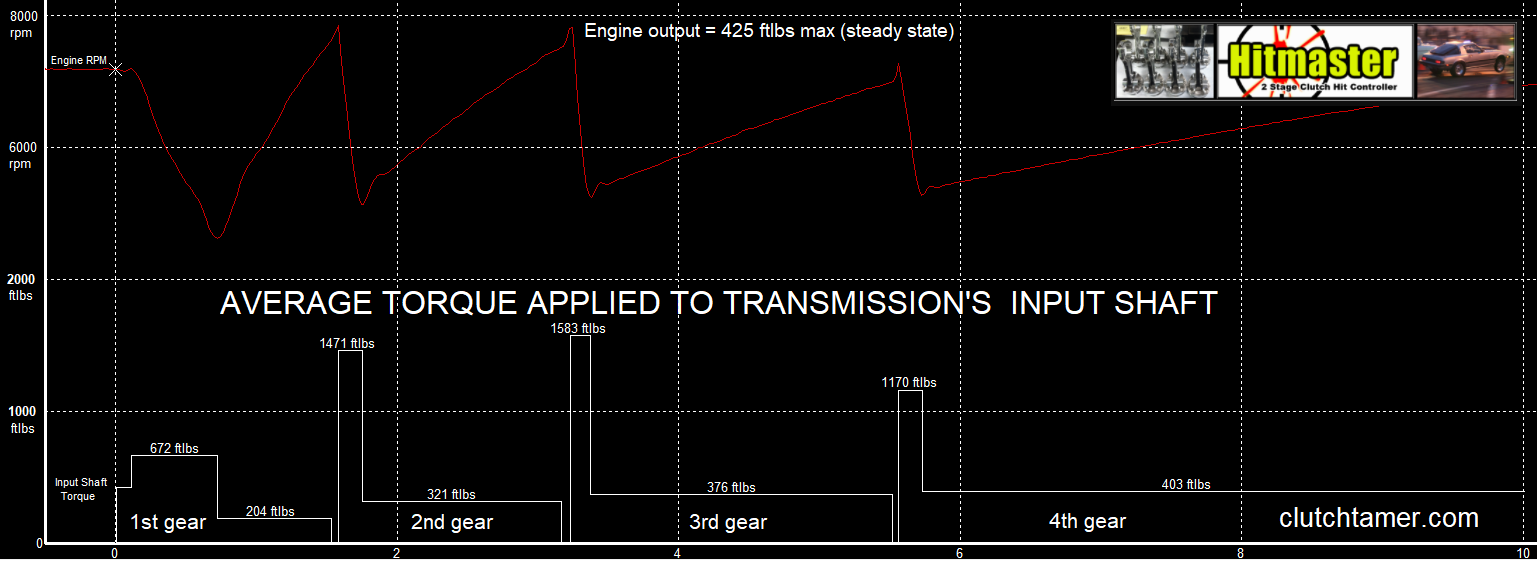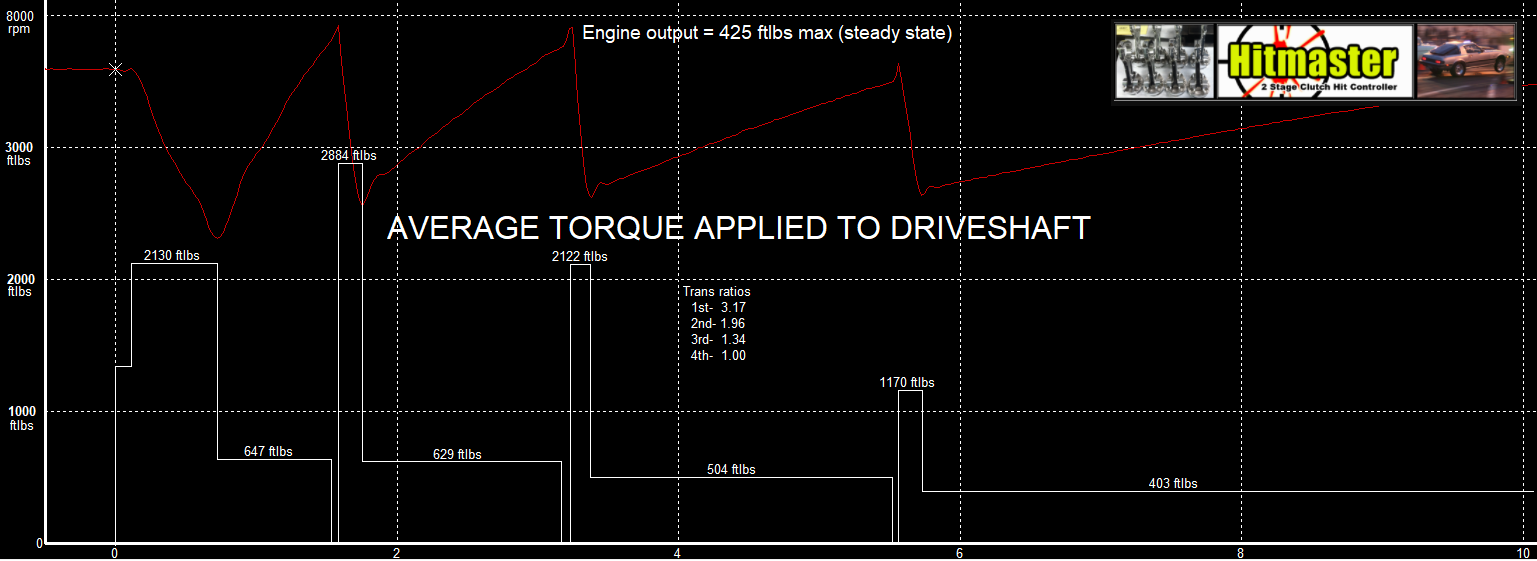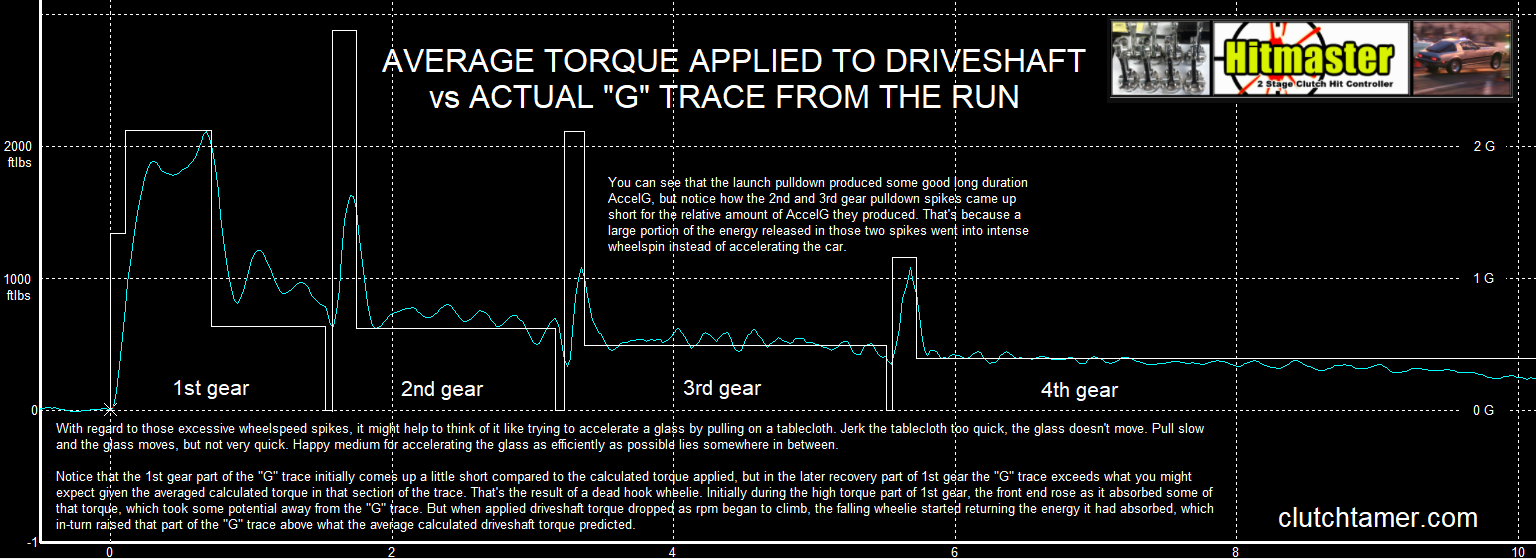|
|
|
#11 | |
|
Junior Member
Join Date: Apr 2016
Posts: 54
Likes: 1
Liked 18 Times in 15 Posts
|
Quote:
When you are launching way over the engine's peak torque, the clutch hits harder and your engine is likely initially losing rpm during launch. That loss of engine rpm adds torque to the transmission's input shaft. That extra torque due to stored energy exiting the engine's rotating assy, along with a harder hitting clutch, causes excessive wheelspin before the car gets a chance to transfer weight. When you are launching from a lower rpm closer to your engine's torque peak, the clutch slips more and the engine may or may not lose rpm. If it doesn't lose rpm, the input shaft will only see engine torque during launch. If you launch below the engine's torque peak, the engine will gain rpm during launch. In that case the engine's rotating assy will absorb some of the engine's torque, which will in-turn reduce the torque that the input shaft sees. Note on the graph below that this 425ftlb engine puts out way more than 425ftlbs when it is losing rpm, and much less than 425ftlbs when it is gaining rpm. That's due to the engine's rotating assy releasing and absorbing energy as it loses or gains rpm...  Here's those calculated input shaft torque numbers multiplied by the transmission ratios to show driveshaft torque...  If you are wondering how accurate those calculated torque numbers might be, here's those calculated driveshaft torque numbers compared to the actual AccelG trace from that pass... 
__________________
Grant website- http://ClutchTamer.com We make your non-adjustable clutch...ADJUSTABLE! |
|
|
|

|
|
|
#12 |
|
Senior Member
Join Date: Jun 2011
Location: Ga.
Posts: 521
Likes: 7
Liked 13 Times in 11 Posts
|
Weedburner , that's good stuff and my take away ( and what I'd been realizing lately ) is that I've been launching with too much RPM. I'd just figured I needed that engine speed but now realize I've missed the target all along....which will have me drop from , say 7000 or so to 6000 or so...this is a 393 SBC ( n/a ).
|
|
|

|
|
|
#13 |
|
Junior Member
Join Date: Apr 2016
Posts: 54
Likes: 1
Liked 18 Times in 15 Posts
|
If you are looking for your best ET, more launch rpm is better as you will have more stored energy available to get the car moving. Problem is the traditional model of adjustable static+CW clutch tuning won't get you there,
Don't confuse more launch rpm with a heavier flywheel as they are not the same with regards to storing energy prior to the start. While a heavier flywheel/clutch will also make more stored energy available for launch, the problem with a heavier flywheel is that the energy you draw from it during launch then has to be paid back before you cross the stripe. The car can launch harder with more stored energy available, but it will then accelerate slower as the rpm's climb back up. Gain some here, lose some there, it basically balances out when the outflow of stored energy is efficient. The problem you see with a heavier flywheel is that it increases the percentage of stored energy that is lost when the tires spin. That is the basic reason drag racers see benefits when switching to lighter clutch/flywheels, an overall reduction of stored energy means less stored energy ends up wasted during wheelspeed spikes after the shifts. It might help to think of the engine's rotating assy as a torque storage device similar to a battery. You lose engine torque output as you charge it up with rpm, then gain engine torque output as you draw rpm out of it. When you cross the stripe, the engine's rotating assy will be fully charged with rpm. Sure there will be give and take as the engine loses and regains rpm as the car works its way thru the gears, but those gains and losses basically cancel each other out. The thing to look at is the net difference between engine rpm on the starting line vs engine rpm crossing the finish line. ...If the rpm on the starting line is the same as crossing the finish line, then all the engine's torque production made it to the transmission's input shaft to accelerate the car. Start with a full battery, end with a full battery. ...If the rpm on the starting line is lower vs crossing the finish line, that's like starting out with less than a fully charged battery. Some of the engine's overall net torque production gets absorbed charging its rotating assy, reducing the overall net torque available to accelerate the car between the start/finish lines. ...If the rpm on the starting line is higher vs crossing the finish line, then that extra start rpm becomes energy available for launch that doesn't have to be paid back before crossing the stripe. You end up with more torque available to accelerate the car between the start and finish lines than the engine actually produced. The key to taking advantage of high rpm starts is the ability to control the stored energy discharge rate, which is in-turn controlled by how fast the clutch pulls the engine down against WOT. For that you need a 2-stage clutch. A 1st stage that maximizes efficiency during high rpm launch, then a 2nd stage rate that maximizes efficiency after the shifts.
__________________
Grant website- http://ClutchTamer.com We make your non-adjustable clutch...ADJUSTABLE! Last edited by weedburner; 10-08-2022 at 03:46 PM. |
|
|

|
| Liked |
|
|
#14 | |
|
Member
Join Date: Apr 2022
Location: Noblesville,In
Posts: 109
Likes: 7
Liked 60 Times in 37 Posts
|
Quote:
Hemi cars cross the stripe at over 9500 so you want us to launch there! Lmao no clue
__________________
SS/AH 328X |
|
|
|

|
| Liked |
|
|
#15 | |
|
Senior Member
Join Date: Apr 2020
Location: Phila, PA
Posts: 619
Likes: 0
Liked 556 Times in 293 Posts
|
Quote:
There is another case where the car is geared for the best 60' time and et which has it on the rev limiter before the finish line. Stan |
|
|
|

|
|
|
#16 |
|
Junior Member
Join Date: Apr 2016
Posts: 54
Likes: 1
Liked 18 Times in 15 Posts
|
So what is it that keeps you from launching from 9500 or above?
__________________
Grant website- http://ClutchTamer.com We make your non-adjustable clutch...ADJUSTABLE! |
|
|

|
|
|
#17 | |
|
Senior Member
Join Date: Jun 2011
Location: Ga.
Posts: 521
Likes: 7
Liked 13 Times in 11 Posts
|
Quote:
I had already considered what Pro Stock cars do , but I'd have a hell of a time applying that tactic to what I do. |
|
|
|

|
|
|
#18 | |
|
Junior Member
Join Date: Apr 2016
Posts: 54
Likes: 1
Liked 18 Times in 15 Posts
|
Quote:
A clutch that is all static is even worse, until you add the ability to control throw-out bearing position during launch. The ability to adjust clamp pressure during launch changes everything. It allows you to add more area under the rpm trace during launch without blowing the tires off. Also allows you to add more area under the rpm trace after the shifts, which in-turn reduces the intensity of wheelspeed spikes. Some guys get it, some don't. A quote relayed to me from Ralph of Total Venue Concepts (NHRA/NMRA/NMCA track prep)- "all clutch cars should have a 'tamer because they don’t rip the **** out of the track!"
__________________
Grant website- http://ClutchTamer.com We make your non-adjustable clutch...ADJUSTABLE! |
|
|
|

|
| Liked |
|
|
#19 | |
|
VIP Member
Join Date: Dec 2004
Location: Cumming GA
Posts: 1,933
Likes: 1,103
Liked 1,235 Times in 252 Posts
|
Heck, if you are going all out pro mod on your clutch, might as well skip to bang shift Billy! LOL
Quote:
__________________
James Schaechter 3163 STK |
|
|
|

|
|
|
#20 |
|
Senior Member
Join Date: Jun 2011
Location: Ga.
Posts: 521
Likes: 7
Liked 13 Times in 11 Posts
|
Funny video.......
I haven't looked close enough at the product yet , but applying clutch tamers to a clutch assisted Nash might be a PITA. So instead of leaving on the last yellow , now we leave on the "top" bulb....just like a typical bracket car......lol. |
|
|

|
 |
«
Previous Thread
|
Next Thread
»
|
|
All times are GMT -4. The time now is 05:34 AM.































 Linear Mode
Linear Mode

